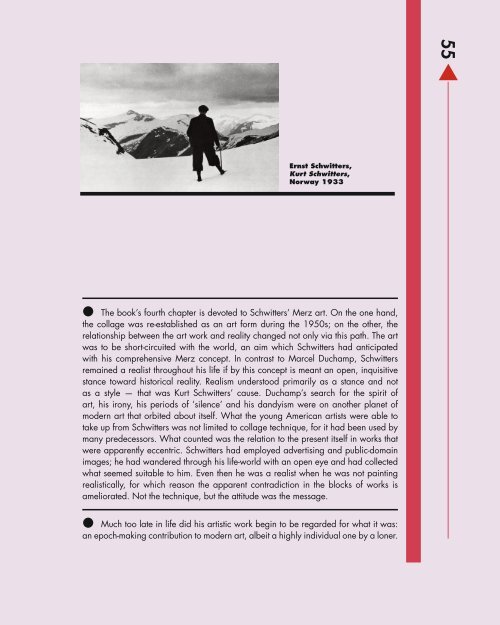Kurt Schwitters: Merz (2016) – Norman Rosenthal interviews Damien Hirst
Fully illustrated catalog published by Galerie Gmurzynska in collaboration with Cabaret Voltaire Zurich on the occasion of Kurt Schwitters: MERZ, a major retrospective exhibition celebrating 100 years of Dada. The exhibition builds and expands on the gallery’s five decade long exhibition history with the artist, featuring exhibition architecture by Zaha Hadid. Edited by Krystyna Gmurzynska and Mathias Rastorfer. First of three planned volumes containing original writings by Kurt Schwitters, historical essays by Ernst Schwitters, Ad Reinhardt and Werner Schmalenbach as well as text contributions by Siegfried Gohr, Adrian Notz, Jonathan Fineberg, Karin Orchard, and Flavin Judd. Foreword by Krystyna Gmurzynska and Mathias Rastorfer. Interview with Damien Hirst conducted by Norman Rosenthal. Includes full color plates and archival photographs. 174 pages, color and b/w illustrations. English. ISBN: 978-3-905792-33-1 The publication includes an Interview with Damien Hirst by Sir Norman Rosenthal about the importance of Kurt Schwitters's practice for Hirst's work.
Fully illustrated catalog published by Galerie Gmurzynska in collaboration with Cabaret Voltaire Zurich on the occasion of Kurt Schwitters: MERZ, a major retrospective exhibition celebrating 100 years of Dada. The exhibition builds and expands on the gallery’s five decade long exhibition history with the artist, featuring exhibition architecture by Zaha Hadid.
Edited by Krystyna Gmurzynska and Mathias Rastorfer.
First of three planned volumes containing original writings by Kurt Schwitters, historical essays by Ernst Schwitters, Ad Reinhardt and Werner Schmalenbach as well as text contributions by Siegfried Gohr, Adrian Notz, Jonathan Fineberg, Karin Orchard, and Flavin Judd.
Foreword by Krystyna Gmurzynska and Mathias Rastorfer.
Interview with Damien Hirst conducted by Norman Rosenthal.
Includes full color plates and archival photographs.
174 pages, color and b/w illustrations.
English.
ISBN:
978-3-905792-33-1
The publication includes an Interview with Damien Hirst by Sir Norman Rosenthal about the importance of Kurt Schwitters's practice for Hirst's work.
Create successful ePaper yourself
Turn your PDF publications into a flip-book with our unique Google optimized e-Paper software.
55<br />
t<br />
Ernst <strong>Schwitters</strong>,<br />
<strong>Kurt</strong> <strong>Schwitters</strong>,<br />
Norway 1933<br />
•<br />
The book’s fourth chapter is devoted to <strong>Schwitters</strong>’ <strong>Merz</strong> art. On the one hand,<br />
the collage was re-established as an art form during the 1950s; on the other, the<br />
relationship between the art work and reality changed not only via this path. The art<br />
was to be short-circuited with the world, an aim which <strong>Schwitters</strong> had anticipated<br />
with his comprehensive <strong>Merz</strong> concept. In contrast to Marcel Duchamp, <strong>Schwitters</strong><br />
remained a realist throughout his life if by this concept is meant an open, inquisitive<br />
stance toward historical reality. Realism understood primarily as a stance and not<br />
as a style — that was <strong>Kurt</strong> <strong>Schwitters</strong>’ cause. Duchamp’s search for the spirit of<br />
art, his irony, his periods of ‘silence’ and his dandyism were on another planet of<br />
modern art that orbited about itself. What the young American artists were able to<br />
take up from <strong>Schwitters</strong> was not limited to collage technique, for it had been used by<br />
many predecessors. What counted was the relation to the present itself in works that<br />
were apparently eccentric. <strong>Schwitters</strong> had employed advertising and public-domain<br />
images; he had wandered through his life-world with an open eye and had collected<br />
what seemed suitable to him. Even then he was a realist when he was not painting<br />
realistically, for which reason the apparent contradiction in the blocks of works is<br />
ameliorated. Not the technique, but the attitude was the message.<br />
•<br />
Much too late in life did his artistic work begin to be regarded for what it was:<br />
an epoch-making contribution to modern art, albeit a highly individual one by a loner.

















